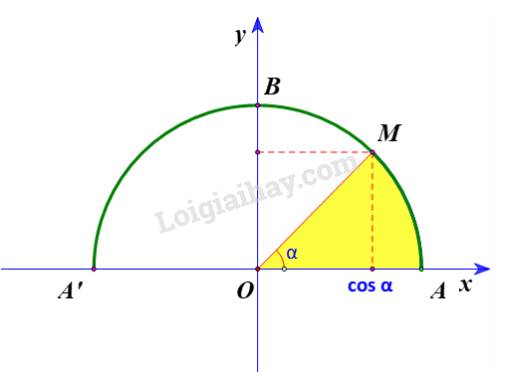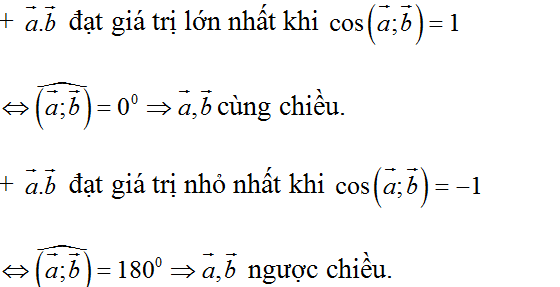Từ định nghĩa tích vô hướng \(\overrightarrow{u}.\overrightarrow{v}=u.v.cos\left(\overrightarrow{u};\overrightarrow{v}\right)\)chứng minh \(\overrightarrow{u}\left(a;b\right)\),\(\overrightarrow{v}\left(m;n\right)\)=(a.m;b.n)

Những câu hỏi liên quan
Tích vô hướng và góc giữa hai vectơ \(\overrightarrow u = \left( {0; - 5} \right),\;\overrightarrow v = \left( {\sqrt 3 ;1} \right)\)
Ta có: \(\overrightarrow u = \left( {0; - 5} \right),\;\overrightarrow v = \left( {\sqrt 3 ;1} \right)\)
\( \Rightarrow \overrightarrow u .\;\,\overrightarrow v = 0.\sqrt 3 + \left( { - 5} \right).1 = - 5.\)
Đúng 0
Bình luận (0)
Nhắc lại định nghĩa tích vô hướng của hai vectơ \(\overrightarrow{a}\) và \(\overrightarrow{b}\). Tích vô hướng này với \(\left|\overrightarrow{a}\right|\) và \(\left|\overrightarrow{b}\right|\) không đổi đạt giá trị lớn nhất và nhỏ nhất khi nào ?
Quan sát Hình 1. Từ hai cách tính tích vô hướng của vectơ overrightarrow {OM} ,overrightarrow {ON} sau đây:overrightarrow {OM} .overrightarrow {ON} left| {overrightarrow {OM} } right|.left| {overrightarrow {ON} } right|.cosleft( {overrightarrow {OM} ,overrightarrow {ON} } right) cosleft( {overrightarrow {OM} ,overrightarrow {ON} } right) cosleft( {alpha - beta } right)overrightarrow {OM} .overrightarrow {ON} {x_M}.{x_N} + {y_M}.{y_N}Hãy suy ra công thức tính cos(α – β) theo các giá trị l...
Đọc tiếp
Quan sát Hình 1. Từ hai cách tính tích vô hướng của vectơ \(\overrightarrow {OM} ,\overrightarrow {ON} \) sau đây:

\(\overrightarrow {OM} .\overrightarrow {ON} = \left| {\overrightarrow {OM} } \right|.\left| {\overrightarrow {ON} } \right|.cos\left( {\overrightarrow {OM} ,\overrightarrow {ON} } \right)\)\( = cos\left( {\overrightarrow {OM} ,\overrightarrow {ON} } \right) = cos\left( {\alpha - \beta } \right)\)
\(\overrightarrow {OM} .\overrightarrow {ON} = {x_M}.{x_N} + {y_M}.{y_N}\)
Hãy suy ra công thức tính cos(α – β) theo các giá trị lượng giác của α và β. Từ đó, hãy suy ra công thức cos(α + β) bằng cách thay β bằng – β.
\(cos\left(\alpha-\beta\right)=x_M\cdot x_N=cos\alpha\cdot cos\beta+sin\alpha\cdot sin\beta\\ cos\left(\alpha+\beta\right)=cos\left[\alpha-\left(-\beta\right)\right]=cos\alpha\cdot cos\left(-\beta\right)+sin\alpha\cdot sin\left(-\beta\right)=cos\alpha\cdot cos\beta-sin\alpha\cdot sin\beta\)
Đúng 0
Bình luận (0)
cho overrightarrow{u}left(3;-2right),overrightarrow{v}left(1;6right).khẳng điịnh nào đúng ?
A.overrightarrow{u}+overrightarrow{v},overrightarrow{a}left(-4;4right)ngược hướng B.overrightarrow{u},overrightarrow{v}cùng phương
C. overrightarrow{u}-overrightarrow{v},overrightarrow{b}left(6;-24right)cùng hướng D. 2overrightarrow{u}+overrightarrow{v},overrightarrow{v}cùng phương
Đọc tiếp
cho \(\overrightarrow{u}=\left(3;-2\right),\overrightarrow{v}=\left(1;6\right).\)khẳng điịnh nào đúng ?
A.\(\overrightarrow{u}+\overrightarrow{v},\overrightarrow{a}=\left(-4;4\right)\)ngược hướng B.\(\overrightarrow{u},\overrightarrow{v}\)cùng phương
C. \(\overrightarrow{u}-\overrightarrow{v},\overrightarrow{b}=\left(6;-24\right)\)cùng hướng D. \(2\overrightarrow{u}+\overrightarrow{v},\overrightarrow{v}\)cùng phương
Khi nào thì tích vô hướng của hai vectơ \(\overrightarrow u ,\;\overrightarrow v \) là một số dương? Là một số âm?
Tham khảo:
Dễ thấy: \(\overrightarrow u .\;\overrightarrow v \) cùng dấu với \(\cos \;\left( {\overrightarrow u ,\;\overrightarrow v } \right)\) (do \(\left| {\overrightarrow u } \right|.\;\left| {\overrightarrow v } \right| > 0\)). Do đó:
+) \(\overrightarrow u .\;\overrightarrow v \;\; > 0\) \( \Leftrightarrow \cos \;\left( {\overrightarrow u ,\;\overrightarrow v } \right) > 0\) hay \({0^o} \le \left( {\overrightarrow u ,\;\overrightarrow v } \right) < {90^o}\)

+) \(\overrightarrow u .\;\overrightarrow v \;\; < 0\) \( \Leftrightarrow \cos \;\left( {\overrightarrow u ,\;\overrightarrow v } \right)\;\; < 0\) hay \({90^o} < \left( {\overrightarrow u ,\;\overrightarrow v } \right) \le {180^o}\)
Vậy \(\overrightarrow u .\;\overrightarrow v \;\; > 0\) nếu \({0^o} \le \left( {\overrightarrow u ,\;\overrightarrow v } \right) < {90^o}\) và \(\overrightarrow u .\;\overrightarrow v \;\; < 0\) nếu \({90^o} < \left( {\overrightarrow u ,\;\overrightarrow v } \right) \le {180^o}.\)
Đúng 0
Bình luận (0)
Tìm điều kiện của \(\overrightarrow u ,\;\overrightarrow v \) để:
a) \(\overrightarrow u .\;\overrightarrow v = \left| {\overrightarrow u } \right|.\;\left| {\overrightarrow v } \right|\)
b) \(\overrightarrow u .\;\overrightarrow v = - \left| {\overrightarrow u } \right|.\;\left| {\overrightarrow v } \right|\)
a)
Ta có: \(\overrightarrow u .\;\overrightarrow v = \left| {\overrightarrow u } \right|.\;\left| {\overrightarrow v } \right|.\cos \left( {\overrightarrow u ,\;\overrightarrow v } \right) = \left| {\overrightarrow u } \right|.\;\left| {\overrightarrow v } \right|\)
\( \Rightarrow \cos \left( {\overrightarrow u ,\;\overrightarrow v } \right) = 1 \Leftrightarrow \left( {\overrightarrow u ,\;\overrightarrow v } \right) = {0^o}\)
Nói cách khác: \(\overrightarrow u ,\;\overrightarrow v \) cùng hướng.
b)
Ta có: \(\overrightarrow u .\;\overrightarrow v = \left| {\overrightarrow u } \right|.\;\left| {\overrightarrow v } \right|.\cos \left( {\overrightarrow u ,\;\overrightarrow v } \right) =- \left| {\overrightarrow u } \right|.\;\left| {\overrightarrow v } \right|\)
\( \Rightarrow \cos \left( {\overrightarrow u ,\;\overrightarrow v } \right) = - 1 \Leftrightarrow \left( {\overrightarrow u ,\;\overrightarrow v } \right) = {180^o}\)
Nói cách khác: \(\overrightarrow u ,\;\overrightarrow v \) ngược hướng.
Đúng 0
Bình luận (0)
Hãy chỉ ra trên Hình 4.26 hai vecto \(3\left( {\overrightarrow u + \overrightarrow v } \right)\) và \(3\overrightarrow u + 3\overrightarrow v \). Từ đó, nêu mối quan hệ giữa \(3\left( {\overrightarrow u + \overrightarrow v } \right)\) và \(3\overrightarrow u + 3\overrightarrow v \)
Tham khảo:
Kí hiệu O, E, F là các điểm như trên hình vẽ.
Dễ thấy: tứ giác OEMF là hình bình hành nên \(\overrightarrow {OE} + \overrightarrow {OF} = \overrightarrow {OM} \) hay \(\overrightarrow v + \overrightarrow u = \overrightarrow {OM} \)
Và \(\overrightarrow {OC} = 3.\overrightarrow {OM} \Rightarrow 3\left( {\overrightarrow v + \overrightarrow u } \right) = 3.\overrightarrow {OM} = \overrightarrow {OC} \)
Mặt khác: \(\overrightarrow {OA} = 3.\overrightarrow {OF} = 3\;\overrightarrow u ;\;\overrightarrow {OB} = 3.\overrightarrow {OE} = 3\;\overrightarrow v \)
Và \(\overrightarrow {OB} + \overrightarrow {OA} = \overrightarrow {OC} \) hay \(3\;\overrightarrow v + 3\;\overrightarrow u = \overrightarrow {OC} \)
\( \Rightarrow 3\left( {\overrightarrow v + \overrightarrow u } \right) = 3\;\overrightarrow v + 3\;\overrightarrow u \)
Đúng 0
Bình luận (0)
Cho hai overrightarrow{u}và overrightarrow{v}có giá vuông góc với nhau. dựng vectơ overrightarrow{w}left(frac{left|overrightarrow{u}right|+left|overrightarrow{v}right|}{left|overrightarrow{u}+overrightarrow{v}right|}-1right)left(overrightarrow{u}+overrightarrow{v}right)-left(frac{left|overrightarrow{u}right|}{left|overrightarrow{u}right|+left|overrightarrow{u}+overrightarrow{v}right|}overrightarrow{v}+frac{left|overrightarrow{v}right|}{left|overrightarrow{v}right|+left|overrightarrow{u}+overrigh...
Đọc tiếp
Cho hai \(\overrightarrow{u}\)và \(\overrightarrow{v}\)có giá vuông góc với nhau. dựng vectơ
\(\overrightarrow{w}=\left(\frac{\left|\overrightarrow{u}\right|+\left|\overrightarrow{v}\right|}{\left|\overrightarrow{u}+\overrightarrow{v}\right|}-1\right)\left(\overrightarrow{u}+\overrightarrow{v}\right)-\left(\frac{\left|\overrightarrow{u}\right|}{\left|\overrightarrow{u}\right|+\left|\overrightarrow{u}+\overrightarrow{v}\right|}\overrightarrow{v}+\frac{\left|\overrightarrow{v}\right|}{\left|\overrightarrow{v}\right|+\left|\overrightarrow{u}+\overrightarrow{v}\right|}\overrightarrow{u}\right)\)
chứng minh vectơ \(\overrightarrow{w}\)có giá vuông góc với giá của vectơ \(\overrightarrow{u}+\overrightarrow{v}\)
MÌNH ĐANG CẦN NGAY TRONG TỐI NAY MONG CÁC BẠN CÓ THỂ GIÚP MÌNH
CẢM ƠN CÁC BẠN RẤT NHIỀU
Cho hình vuông ABCD có cạnh 6aa) tính độ dài các vecto sau overrightarrow{u}overrightarrow{AB}-overrightarrow{AC} ; overrightarrow{v}overrightarrow{BC}+overrightarrow{BD}b) tính các tích vô hương sau : overrightarrow{AB}.overrightarrow{AC}; overrightarrow{BD}.overrightarrow{AC};overrightarrow{AB}.overrightarrow{CD}
Đọc tiếp
Cho hình vuông ABCD có cạnh = 6a
a) tính độ dài các vecto sau \(\overrightarrow{u}=\overrightarrow{AB}-\overrightarrow{AC}\) ; \(\overrightarrow{v}=\overrightarrow{BC}+\overrightarrow{BD}\)
b) tính các tích vô hương sau : \(\overrightarrow{AB}.\overrightarrow{AC}\); \(\overrightarrow{BD}.\overrightarrow{AC}\);\(\overrightarrow{AB}.\overrightarrow{CD}\)
a: AB=BC=CD=DA=6a
\(AC=BD=\sqrt{\left(6a\right)^2+\left(6a\right)^2}=6a\sqrt{2}\)
\(\left|\overrightarrow{AB}-\overrightarrow{AC}\right|=\left|\overrightarrow{CA}+\overrightarrow{AB}\right|=CB=6a\)
\(\left|\overrightarrow{BC}+\overrightarrow{BD}\right|=\sqrt{BC^2+BD^2+2\cdot BC\cdot BD\cdot cos45}\)
\(=\sqrt{36a^2+72a^2+\sqrt{2}\cdot6a\cdot6a\sqrt{2}}\)
\(=6a\sqrt{5}\)
b: \(\overrightarrow{AB}\cdot\overrightarrow{AC}=AB\cdot AC\cdot cos\left(\overrightarrow{AB},\overrightarrow{AC}\right)=6a\cdot6a\sqrt{2}\cdot\dfrac{\sqrt{2}}{2}\)
\(=36a^2\)
Đúng 2
Bình luận (0)















